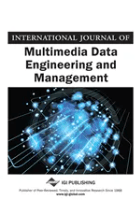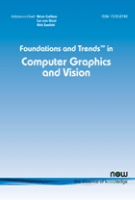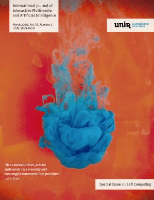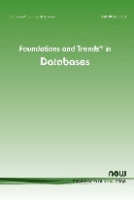
International Journal of Multimedia Data Engineering & Management
Scope & Guideline
Innovating Approaches to Data Management Excellence
Introduction
Aims and Scopes
- Multimodal Data Integration:
The journal emphasizes the integration of various types of data (e.g., audio, video, text) to enhance user experiences and application functionalities, particularly in fields like augmented reality and virtual environments. - Advanced Data Visualization Techniques:
Research focusing on novel visualization methods, including dashboards and interactive systems, that facilitate the understanding and interpretation of complex multimedia datasets. - Machine Learning and AI Applications:
A strong focus on the development and application of machine learning and artificial intelligence techniques to improve data processing, analysis, and automated decision-making in multimedia contexts. - User Interaction and Experience Design:
Exploration of user-centric design principles aimed at improving interaction with multimedia systems, including personalized experiences and accessibility for diverse user groups. - Performance Optimization and Efficiency:
Research addressing optimization techniques for multimedia processing, including algorithms and frameworks that enhance the performance of multimedia applications.
Trending and Emerging
- Augmented and Virtual Reality Applications:
There is a growing emphasis on the integration of multimedia data within augmented and virtual reality environments, showcasing innovative approaches to enhance user interaction and experience. - Explainability and Transparency in AI:
Research focusing on the explainability of AI models, particularly in image recognition and other multimedia applications, is gaining importance as stakeholders demand more transparency in automated decisions. - Personalized and Adaptive Systems:
The trend towards personalized experiences in multimedia applications is on the rise, with a focus on developing systems that adapt to individual user preferences and needs. - Multimodal Interaction Techniques:
There is an increasing interest in exploring multimodal interaction methods that combine various input types (e.g., voice, gesture, visual) to create more engaging and effective user experiences. - Advanced Analytics in Multimedia Data Management:
The emergence of sophisticated analytics frameworks that leverage big data techniques to derive insights from multimedia datasets is becoming a focal point of research, driven by the need for actionable intelligence.
Declining or Waning
- Traditional Multimedia Encryption Techniques:
Research related to conventional encryption methods for multimedia data has decreased, possibly due to the emergence of more sophisticated and efficient security measures that leverage modern cryptographic techniques. - Basic Multimedia Data Compression:
There has been a noticeable decline in studies centered on fundamental data compression techniques, as newer algorithms and frameworks that provide better performance and efficiency are being prioritized. - Static User Interface Designs:
Research focusing on static or non-interactive user interface designs is waning, as the current trend favors dynamic and adaptive user experiences that respond to real-time data and user interactions.
Similar Journals

Foundations and Trends in Computer Graphics and Vision
Navigating the Future of Graphics and VisionFoundations and Trends in Computer Graphics and Vision, published by NOW PUBLISHERS INC, is a premier journal dedicated to advancing the fields of computer graphics and vision. With an impressive impact factor and ranked Q1 in the Computer Vision and Pattern Recognition category, this journal has established itself as a vital resource for cutting-edge research and trends. Spanning from 2005 to 2024, it covers a wide array of topics within its scope, featuring comprehensive reviews and insights that are essential for professionals, researchers, and students alike. The journal’s high Scopus rank, placing it in the top 4 of 106 in its discipline, underscores its relevance and authority in the field. While currently not offering open access, the importance of its curated content makes it a valuable addition to any academic library and a must-read for those looking to stay at the forefront of computer graphics and vision advancements.

COMPUTER MUSIC JOURNAL
Pioneering Research in the World of Computer MusicComputer Music Journal, published by MIT Press, stands as a prominent platform for scholarly discourse in the intersection of music and technology. With its origins dating back to 1982, the journal spans an extensive range of topics, from computer-generated music and sound synthesis to interactive musical systems and multimedia art. Despite not being an open-access journal, it has garnered significant recognition, reflected in its rankings across various fields—placing 22nd in Music within Arts and Humanities and achieving a Q2 category status in Music for 2023. This publication is invaluable for researchers, practitioners, and enthusiasts alike, offering critical insights that expand the boundaries of musical composition and technological innovation. With its robust history and commitment to advancing the understanding of computer music, the Computer Music Journal continues to be a critical resource in both the academic and artistic communities.

International Journal of Interactive Multimedia and Artificial Intelligence
Fostering Global Insights in AI and MultimediaThe International Journal of Interactive Multimedia and Artificial Intelligence, published by UNIV INT RIOJA-UNIR in Spain, is a leading Open Access journal that has been fostering knowledge dissemination in the field since 2008. With an ISSN of 1989-1660 and an impressive impact characterized by its Q1 and Q2 rankings across major categories in Artificial Intelligence and Computer Science, the journal serves as a crucial platform for researchers and professionals eager to explore innovative applications and technological advancements. This journal is particularly distinguished by its commitment to high-quality peer-reviewed research, evident in its current Scopus rankings, which place it among the top percentile in various computer science domains, including Statistics, Signal Processing, and Computer Vision. The journal's scope encompasses a wide array of topics that intersect with multimedia and artificial intelligence, making it an invaluable resource for students and emerging scholars aiming to deepen their understanding and contribute to these vibrant fields. Through its Open Access model, it ensures that research is accessible to a global audience, thus enhancing the visibility and impact of the scientific discourse.

Journal of Web Engineering
Connecting Scholars in the Evolving Digital LandscapeThe Journal of Web Engineering, published by RIVER PUBLISHERS, serves as a pivotal platform for researchers, professionals, and students interested in the expanding fields of web technologies and engineering. Since its inception in 2008, this journal has dedicated itself to advancing knowledge and promoting innovative practices in Computer Networks and Communications, Information Systems, and Software Engineering. With an impressive convergence of research up to 2024, its Q3 quartile ranking in both Computer Networks and Communications and Information Systems reflects the journal's commitment to the dissemination of high-quality, impactful research. Although it operates as a traditional access journal, it allows for vital contributions to be shared widely among a diverse readership. The Journal of Web Engineering's rankings in Scopus, including a percentile placement of 28th in Computer Networks and Communications, demonstrate its relevance and growing significance in the academic landscape. As the digital world continuously evolves, this journal remains a crucial resource for exploring the latest advancements and theoretical reflections within the realm of web engineering.

International Journal of Education and Information Technologies
Bridging the Gap between Learning and TechnologyWelcome to the International Journal of Education and Information Technologies, a leading academic platform published by NORTH ATLANTIC UNIV UNION-NAUN. With an emphasis on the integration of education and information technology, this journal aims to foster innovative research and discussions that enhance pedagogical practices and technological advancements in educational contexts. Although currently an open access journal, it provides unrestricted access to emerging studies that are crucial for educators, researchers, and professionals aiming to stay at the forefront of education technology. While specific metrics such as H-index and Scopus ranks are yet to be defined, its ISSN 2074-1316 signifies its credibility and commitment to quality scholarship. This journal serves as a vital resource for those passionate about bridging the gap between technology and education, encouraging impactful research that shapes the future of learning environments.

International Journal of Multimedia Information Retrieval
Unlocking Insights in Multimedia Information RetrievalThe International Journal of Multimedia Information Retrieval, published by Springer, stands at the forefront of research dedicated to the dynamic fields of information systems, library and information sciences, and media technology. With an impressive impact factor reflected in its prestigious Q1 ranking across multiple categories in 2023, this journal serves as a critical resource for scholars and professionals aiming to explore the intersections of multimedia content and information retrieval systems. Established in 2012, the journal continues to advance knowledge through its rigorous peer-reviewed articles, which address contemporary challenges and innovative solutions in the digital information landscape. Researchers and practitioners alike can benefit from the insights presented within its pages, ensuring a lasting impact on both academic and applied facets of multimedia information retrieval. Located in the United Kingdom with access options available through traditional subscriptions, the journal welcomes contributions that push the boundaries of knowledge in this essential area of study.

Foundations and Trends in Databases
Exploring the Future of Data ManagementFoundations and Trends in Databases is a prestigious journal published by NOW PUBLISHERS INC, focusing on the dynamic field of database research. With an ISSN of 1931-7883 and an E-ISSN of 1931-7891, this journal has solidified its reputation as a leading publication in computer science, attaining a remarkable Q1 ranking in the Computer Science (miscellaneous) category for 2023. Spanning various converged years since its inception in 2007, the journal aims to provide comprehensive reviews and insights that drive forward the understanding of databases and their numerous applications. Although it operates under a subscription model, the journal’s release of high-impact, well-cited articles positions it as an essential resource for researchers, professionals, and students keen on exploring the latest advancements and challenges in database technologies. With a Scopus rank of #22/232 in General Computer Science, this journal not only showcases innovative research but also facilitates a deeper discourse in the thriving world of data management.

International Journal of Digital Multimedia Broadcasting
Advancing the Future of Multimedia BroadcastingThe International Journal of Digital Multimedia Broadcasting is a leading scholarly platform dedicated to the interdisciplinary exploration of digital multimedia broadcasting, published by HINDAWI LTD. With an ISSN of 1687-7578 and an E-ISSN of 1687-7586, this Open Access journal has made significant strides since its inception in 2008, ensuring wide accessibility and dissemination of research. Based in the United States, at Adam House, 3rd Flr, 1 Fitzroy Sq, London W1T 5HF, England, the journal covers a range of topics relevant to Communication, Electrical and Electronic Engineering, and Media Technology, boasting impressive Scopus rankings that highlight its influence in these fields. As part of the Q3 category in Communication and Electrical Engineering, and Q2 in Media Technology for 2023, the journal serves a vital role in fostering the understanding of technological advancements and their applications in multimedia broadcasting. Researchers, professionals, and students are encouraged to contribute to and benefit from the journal's rich repository of knowledge, paving the way for innovative developments in this dynamic industry.

International Journal of Cognitive Informatics and Natural Intelligence
Fostering Collaborative Insights in Cognitive TechnologiesThe International Journal of Cognitive Informatics and Natural Intelligence, published by IGI Global, is an essential resource for researchers and professionals exploring the intersections of cognitive informatics, artificial intelligence, and human-computer interaction. Since its establishment in 2007, this journal has focused on advancing the understanding of cognitive systems and their applications in natural intelligence, contributing significantly to the fields of software engineering and interface design. Operating out of the United States, the journal aims to disseminate high-quality research and innovative methodologies to foster interdisciplinary collaboration. Despite its current standing in Q4 quartiles for the fields of Artificial Intelligence, Human-Computer Interaction, and Software, it serves as a vital platform for emerging scholars and seasoned professionals alike seeking to explore new frontiers in cognitive technologies. While it does not provide direct open access, these publications are instrumental in shaping academic discourse, and contribute to ongoing advancements in how we understand and integrate cognitive science into practical applications.

KSII Transactions on Internet and Information Systems
Connecting Ideas, Transforming Knowledge in Information Systems.KSII Transactions on Internet and Information Systems is a leading academic journal dedicated to advancing the fields of Internet technology and information systems. Published by the KSII-Kor Soc Internet Information, this journal has established itself as a significant contributor to research since its inception in 2007, with a focus on innovative solutions and methodologies in computer networks and communications as well as information systems. With a Category Quartile of Q3 in both fields for 2023, it ranks in the 44th percentile among its peers according to Scopus, making it a reputable platform for authors to share their findings. While available in print, the journal also promotes open access, ensuring broad dissemination of research findings. The editorial team is committed to maintaining high scholarly standards and relevance, inviting contributions from researchers, professionals, and students eager to push the boundaries of knowledge in today's rapidly evolving digital landscape. For those engaged in or studying these dynamic fields, the KSII Transactions on Internet and Information Systems remains an invaluable resource for cutting-edge research.